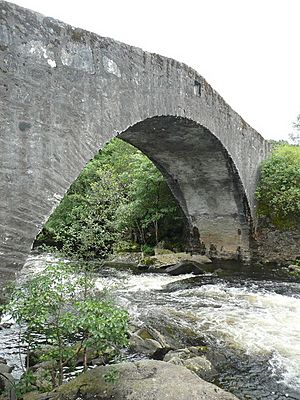Atholl raids facts for kids
Quick facts for kids Atholl raids |
|||||||
|---|---|---|---|---|---|---|---|
| Part of the Jacobite rising of 1745 | |||||||
 Tummel Bridge, built for General Wade in 1730. Jacobites captured it during the Atholl raids in 1746. |
|||||||
|
|||||||
| Belligerents | |||||||
Campbell of Argyll Militia Loudon's Highlanders |
Atholl Brigade (Clan Murray) Clan Macpherson |
||||||
| Commanders and leaders | |||||||
| Strength | |||||||
| Atholl Brigade: 400 Macphersons: 300 |
|||||||
| Casualties and losses | |||||||
| 2 killed 8 or 10 wounded 300 taken prisoner |
unknown | ||||||
The Atholl raids happened between March 14 and 17, 1746. These were a series of surprise attacks. Jacobite rebels carried them out against the British government. They took place during the Jacobite rising of 1745.
Why the Raids Happened
The British commander in Scotland was Prince William, Duke of Cumberland. He felt safe, even though he heard warnings. A person who escaped from the Jacobites said attacks were planned. These attacks would target British outposts. These outposts were near Blair Atholl and Castle Menzies.
But the Jacobite commander, Lord George Murray, had a plan. He gathered his Atholl Brigade. He also had two small cannons. They marched from Inverness to Strathspey. On March 14, they took over Castle Grant. Murray left 100 men to guard the castle.
In Ruthven, Badenoch, Murray met more allies. Archibald Menzies of Struan and Ewen MacPherson of Cluny joined him. They brought 300 Macphersons. This brought Murray's total force to 700 men.
The Raids Begin
The Jacobite troops split into thirty groups. These groups had both Atholl men and MacPhersons. Each group was given a specific target. The Jacobite force walked 30 miles over hills. They reached their targets by going through the Pass of Killiecrankie.
One target was the post at Bun Rannoch. This post was held by Loudon's 64th Highlanders. Their commander, Colin Campbell of Glenure, was not there. He later said he was getting food for his men at Castle Menzies. His militia men were surrounded at 11 PM on March 16.
The first guard fired his musket, but it did not help. He was quickly surrounded. The next post to the east was Kynachan House. This house guarded an important bridge over the River Tummel. Again, the guard was surrounded and killed.
The Campbell men inside Kynachan House fought back. They fired from small openings in the building. But the Jacobites made a hole in the roof above them. The Campbell men had to surrender. At these two posts, the government lost two men killed. One of them was an officer. Eight or ten men were also wounded.
In total, the Jacobites took twelve militia outposts. They captured 300 government soldiers.
What Happened Next
All of the Jacobites' targets were taken. This included posts held by regular soldiers near Blair Castle. The government's plans to send help failed. The Jacobite general, Lord George Murray, was then able to lay siege to Blair Castle. This siege lasted for two weeks.
The Atholl raids showed that guerrilla warfare tactics worked well. This meant using small, quick attacks. However, it also left the Jacobite army spread out. They had few troops left in the Scottish Highlands. This meant they could not stop the Duke of Cumberland from marching on Inverness. Colin Campbell of Glenure, whose men were defeated at Bun Rannoch, was later killed. This event is known as the Appin Murder.
Bagpipers in Battle
According to historian John Buchan, the Jacobites had many bagpipers. As many as twenty bagpipers were with them during the Atholl raids.
See also

